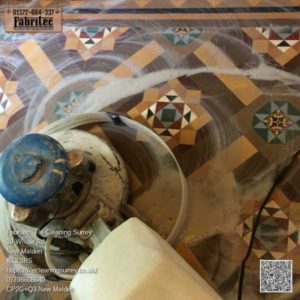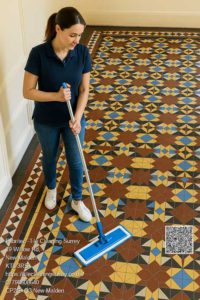Elevate Your Living Space with Expert Restoration Techniques for Victorian Tiles
Victorian hallway tiles not only infuse your home with a sense of historic elegance but also demand careful cleaning and maintenance to retain their captivating beauty. Renowned for their intricate patterns and rich colours, these tiles are a defining feature of 19th-century architecture and continue to be a sought-after choice in contemporary interiors. However, the effects of time bring specific challenges that require expertise in their care. By dedicating the right effort, you can revive their original splendour, ensuring they perpetually enhance the charm and character of your home.
Exploring the Rich Cultural Heritage Embedded in Victorian Tiles
Victorian tiles transcend being mere flooring options; they are remarkable artifacts that narrate a captivating tale of craftsmanship from a bygone era. Fashioned from robust clay and adorned with stunning designs, these tiles encapsulate a profound cultural legacy that warrants preservation. By engaging in the restoration of these historical treasures, homeowners play a vital role in conserving cultural heritage while simultaneously enhancing the value and aesthetic appeal of their homes.
Recognising Common Issues in Neglected Victorian Hallway Tiles
- Loss of Shine and Dullness: A common problem faced by neglected Victorian tiles is the accumulation of wax, often applied by homeowners to enhance shine and protect surfaces. Over time, the wax buildup can obscure the tiles, resulting in a dull and lifeless appearance. Inadequately maintained wax traps dust and dirt, further compromising the vibrancy of the tiles and complicating the restoration process.
- Visible Scratches and Discolouration: Without proper cleaning and care, scratches and discolouration may tarnish the surfaces of Victorian tiles. This deterioration often stems from grit and dirt or the use of harsh cleaning methods that erode the tile surface. The once vibrant colours and intricate designs can fade, leading to unsightly marks and diminishing the tiles' original charm.
- Declining Original Beauty and Character: Perhaps the most disheartening outcome of neglect is the loss of original charm in Victorian tiles. Each tile was meticulously crafted to enhance the elegance of the room. However, neglect can result in faded patterns and washed-out colours, making your space feel outdated and devoid of its historical allure.
Step-by-Step Guide for Restoring Victorian Tiles to Their Former Glory

Step 1: Effective Techniques for Wax Removal
The initial phase of the restoration process involves meticulously removing the layers of old wax with non-abrasive and tile-safe cleaning products that effectively eliminate the buildup without harming the underlying surface. This step is essential to rejuvenate the tiles' natural beauty and prepare them for further restoration.
Step 2: Comprehensive Deep Cleaning to Restore Vibrancy
A professional deep cleaning process specifically targets stubborn grout lines, persistent stains, and ingrained dirt, revealing the tiles’ original vibrancy. This phase is critical for ensuring that any discolouration is addressed, allowing the tiles to reclaim their former splendour and charm.
Step 3: Implementing Robust Moisture Control Solutions
Older properties often lack sufficient modern moisture barriers, making moisture control paramount. We employ dehumidifiers or breathable sealers to avert future moisture complications, ensuring that your tiles remain in prime condition for years to come, safeguarding their beauty and integrity.
Step 4: Applying a Durable Sealer for Long-Term Protection
Ultimately, we apply a breathable impregnating sealer that offers protection against moisture and stains, ensuring long-lasting durability and preserving the stunning appearance of your tiles. This crucial final step is essential for maintaining the quality and longevity of your tiles over time.
Crucial Maintenance Tips to Follow After Restoration
-
1. Select pH-Neutral Cleaners for Optimal Tile Care
When cleaning your Victorian tiles, it is vital to choose suitable cleaning products that will preserve their appearance and safeguard the sealant. pH-neutral cleaners are specifically formulated to gently cleanse surfaces without stripping the sealer or inflicting damage on the tiles. These gentle cleaners will not cause abrasion, discolouration, or fading over time.
Recommended pH-Neutral Cleaners for Victorian Tiles:
- LTP Wash – Ideal for regular cleaning without compromising the integrity of the sealant.
- Fila Multisurface Cleaner – An effective yet gentle solution perfect for maintaining tile surfaces.
2. Establish a Consistent Cleaning Routine to Prevent Buildup

Even after restoration, dirt, dust, and grease can accumulate over time. Establishing a consistent cleaning routine is essential to prevent buildup and maintain the visual appeal of your tiles. Regularly sweep or vacuum to eliminate dirt and debris, and mop with a damp cloth to keep the tiles clean and glossy.
- Tip: Utilise a microfiber mop for gentle yet effective cleaning that won’t scratch the tile surface.
3. Avoid Abrasive Tools and Harsh Chemicals
When caring for Victorian tiles, it's crucial to refrain from using abrasive brushes, harsh scrubbers, or chemical cleaners that can damage the sealant or scratch the tile surface. Abrasive tools can create unsightly marks, dulling the shine and rendering the tiles more susceptible to wear.
Items to Avoid During Cleaning:
- Steel wool pads
- Bleach or ammonia-based cleaners
- Abrasive scrubbing brushes
Instead, opt for soft, non-abrasive sponges or cloths to preserve the tiles.
4. Timely Intervention for Minor Wear and Tear
Over time, minor wear and tear on your tiles is inevitable, but there are effective strategies to address these issues without compromising the overall finish. If you observe small stains or spots that resist removal with regular cleaning, it’s vital to treat them promptly to prevent further damage.
- Spot Cleaning: For stubborn stains, gently rub the affected area with a mild cleaner and a soft cloth.
- Surface Scuffs: Light scuffs can often be buffed out using a microfiber cloth. For more persistent marks, a thin layer of sealer can restore the finish.
Tip: Do not delay in addressing spills. Staining liquids such as wine, coffee, or oil can set quickly, making removal significantly more challenging later on.
5. Reapply the Sealer Regularly for Lasting Protection
While the initial restoration process includes sealing the tiles, it is advisable to reapply the impregnating sealer every few years, depending on foot traffic and wear. The sealer provides a critical barrier against moisture, dirt, and grime, which can otherwise penetrate the tiles and lead to damage.
Steps to Effectively Apply Sealer:
- Ensure the surface is impeccably clean and dry before reapplying the sealer.
- Apply the sealer in thin, even coats, allowing each coat to dry fully before applying the next.
- Pay particular attention to areas with high foot traffic to ensure adequate protection.
The Benefits of Investing in Professional Cleaning for Victorian Hallway Tiles
While some homeowners may contemplate DIY restoration methods, engaging a professional tile restoration service typically yields superior results. Professionals possess the necessary equipment, expertise, and knowledge to handle the delicate nature of Victorian tiles, ensuring a successful restoration process with minimal risk of damage.
Tile restoration specialists can provide:
- Comprehensive cleaning and restoration services tailored specifically for Victorian tiles.
- Expertise in moisture control and sealing to safeguard your tiles against future damage.
- Professional advice on effective long-term maintenance strategies for your tiles.
If you're contemplating restoring your Victorian tiles, seeking professional support can significantly elevate the outcome.
Need Expert Assistance? Connect with Professionals Now
While DIY cleaning is an option, hiring a professional guarantees that no damage occurs to the original surface of your tiles.
Frequently Asked Questions About the Care of Victorian Hallway Tiles
What is the Recommended Cleaning Frequency for My Victorian Hallway Tiles?
Light cleaning should be conducted weekly, with deep cleaning and resealing performed every 1–2 years, contingent on foot traffic levels.
Can Bleach or Vinegar Be Used on My Victorian Tiles?
Certainly not. These substances can erode the tiles and compromise the sealant. Stick to using only pH-neutral cleaners for optimal care.
Is Wax Removal Necessary Prior to Sealing?
Absolutely, removing wax is crucial to ensure that sealers adhere properly and provide enduring protection for your tiles.
Should I Hire a Professional for Tile Restoration Services?
For the best results and to avoid accidental damage, hiring a professional is strongly advised.
The Enduring Allure of Victorian Hallway Tiles
Victorian hallway tiles are stunning relics of history that, with the appropriate cleaning and maintenance, can remain breathtaking for generations. Whether you are restoring a property in Chertsey or simply revitalising your hallway, investing in the care of these historic floors is always a prudent choice.
The Article: Uncover the Shocking Transformation of a Neglected Victorian Hallway In Chertsey first appeared on https://tilecleaningsurrey.co.uk
The Article Victorian Hallway Tiles Cleaning Chertsey: How to Restore & Maintain Timeless Floors first appeared on https://fabritec.org
The Article Victorian Hallway Tiles Cleaning: Restore and Care for Timeless Floors Was Found On https://limitsofstrategy.com

